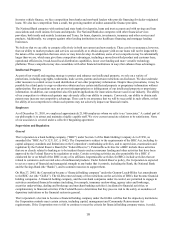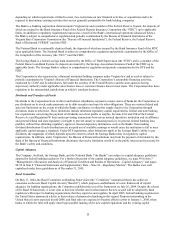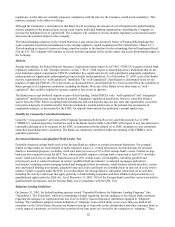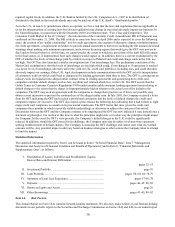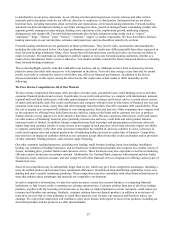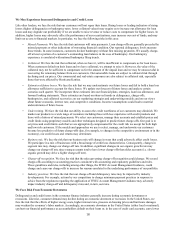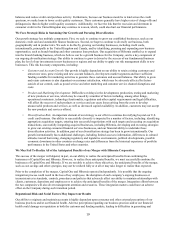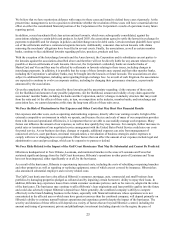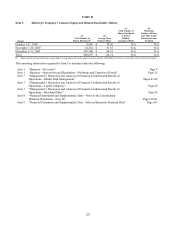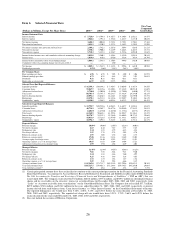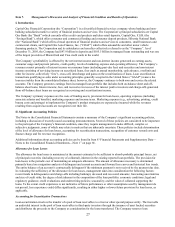Capital One 2005 Annual Report Download - page 26
Download and view the complete annual report
Please find page 26 of the 2005 Capital One annual report below. You can navigate through the pages in the report by either clicking on the pages listed below, or by using the keyword search tool below to find specific information within the annual report.to shareholders, in our proxy statements, in our offering circulars and prospectuses, in press releases and other written
materials and in statements made by our officers, directors or employees to third parties. Statements that are not about
historical facts, including statements about our beliefs and expectations, are forward-looking statements. Forward-looking
statements include information relating to our future earnings per share, growth in managed loans outstanding, product mix,
segment growth, managed revenue margin, funding costs, operations costs, employment growth, marketing expense,
delinquencies and charge-offs. Forward-looking statements also include statements using words such as “expect,”
“anticipate,” “hope,” “intend,” “plan,” “believe,” “estimate,” “target” or similar expressions. We have based these forward-
oking statements on our current plans, estimates and projections, and you should not unduly rely on them. lo
Forward-looking statements are not guarantees of future performance. They involve risks, uncertainties and assumptions,
including the risks discussed below. Our future performance and actual results may differ materially from those expressed in
these forward-looking statements. Many of the factors that will determine these results and values are beyond our ability to
control or predict. We undertake no obligation to publicly update or revise any forward-looking statements, whether as a
result of new information, future events or otherwise. You should carefully consider the factors discussed below in evaluating
these forward-looking statements.
This section highlights specific risks that could affect our business and us. Although we have tried to discuss key factors,
please be aware that other risks may prove to be important in the future. New risks may emerge at any time and we cannot
predict such risks or estimate the extent to which they may affect our financial performance. In addition to the factors
discussed elsewhere in this report, among the other factors that could cause actual results to differ materially are the
following:
W
e Face Intense Competition in All of Our Markets
We face intense competition from many other providers of credit cards, automobile loans, retail banking services and other
consumer financial products and services. In particular, in our credit card activities, we compete with international, national,
regional and local bank card issuers, with other general purpose credit or charge card issuers, and to a certain extent, issuers
of smart cards and debit cards. Our credit card business also competes with providers of other types of financial services and
consumer loans such as home equity lines and other mortgage related products that offer consumer debt consolidation. Thus,
the cost to acquire new accounts will continue to vary among product lines and may rise. Other companies may compete with
us for customers by offering lower initial interest rates and fees, higher credit limits and/or customer services or product
features that are or may appear to be more attractive than those we offer. Because customers often choose credit card issuers
(or other sources of financing) based on price (primarily interest rates and fees), credit limit and other product features,
customer loyalty is limited. In addition, intense competition may lead to product and pricing practices that may adversely
impact long-term customer loyalty; we may choose to not engage in such practices, which may adversely impact our ability
to compete, particularly in the short term. Increased competition has resulted in, and may continue to cause, a decrease in
credit card response rates and reduced productivity of marketing dollars invested in certain lines of business. Competition
may also have an impact on customer attrition as our customers accept offers from other credit card lenders and/or providers
f other consumer lending products, such as home equity financing. o
Our other consumer lending businesses, including auto lending, small business lending, home loan lending, installment
lending, our commercial lending businesses, and our businesses in international markets also compete on a similar variety of
factors, including price, product features and customer service. These businesses may also experience a decline in marketing
efficiency and/or an increase in customer attrition. Additionally, the National Bank competes with national and state banks
for deposits, loans, and trust accounts, and also competes with other financial services companies in offering various types of
financial services.
Some of our competitors may be substantially larger than we are, which may give those competitors advantages, including a
more diversified product and customer base, operational efficiencies, broad-based local distribution capabilities, lower-cost
funding and more versatile technology platforms. These competitors may also consolidate with other financial institutions in
ays that enhance these advantages and intensify our competitive environment. w
In such a competitive environment, we may lose entire accounts, or may lose account balances, to competing financial
institutions, or find it more costly to maintain our existing customer base. Customer attrition from any or all of our lending
products, together with any lowering of interest rates or fees that we might implement to retain customers, could reduce our
revenues and therefore our earnings. Similarly, customer attrition from our deposit products, in addition to an increase of
rates an/or services that we may undertake to retain those deposits, may increase our expenses and therefore reduce our
earnings. We expect that competition will continue to grow more intense with respect to most of our products, including our
diversified products and the products we offer internationally.
17





